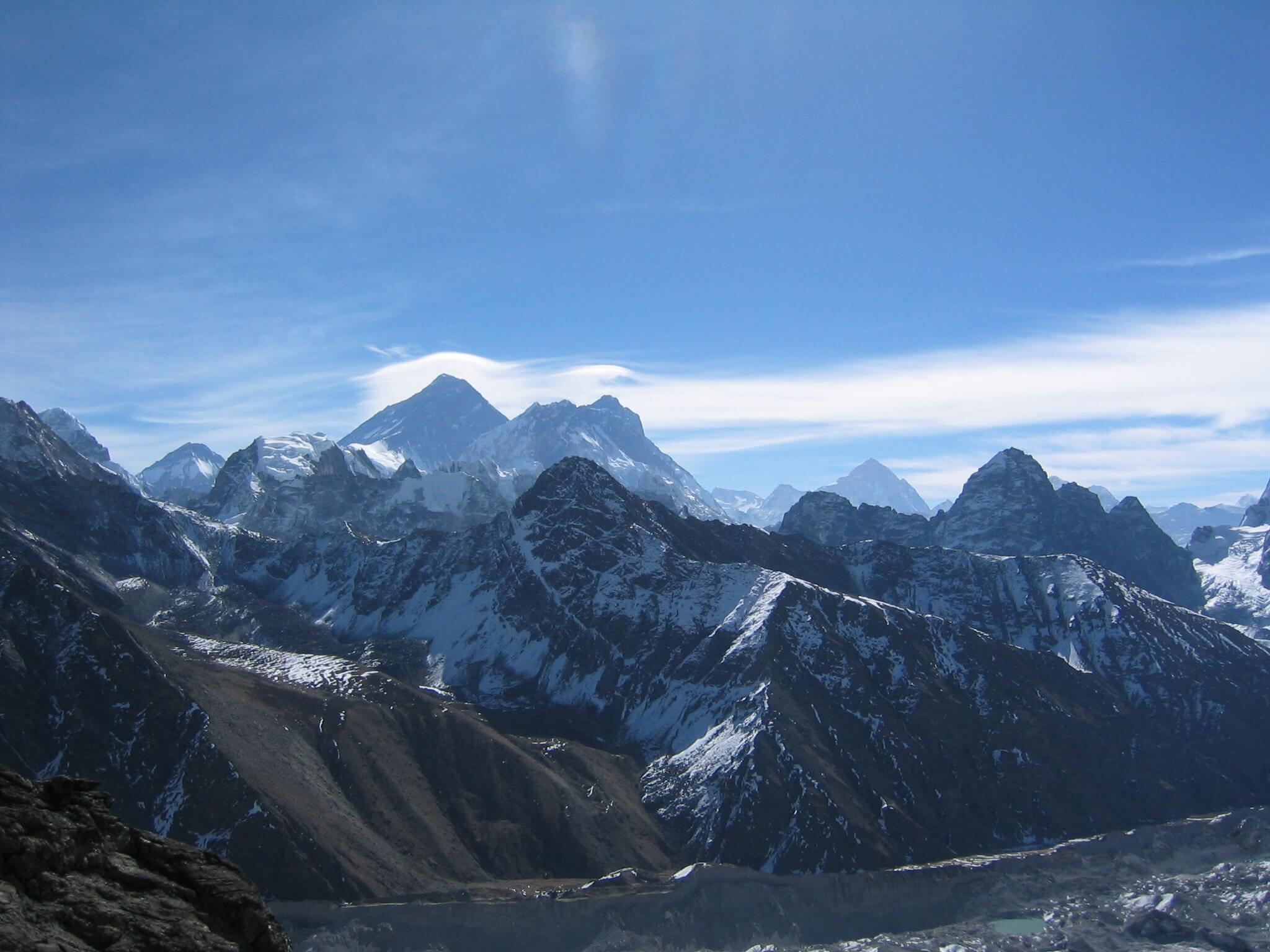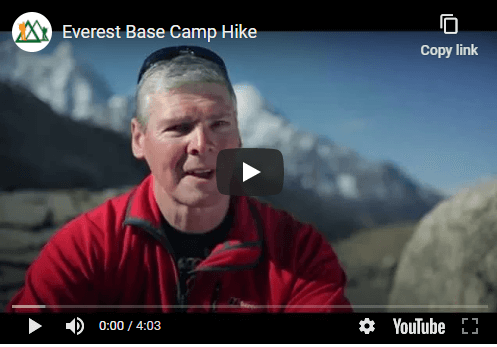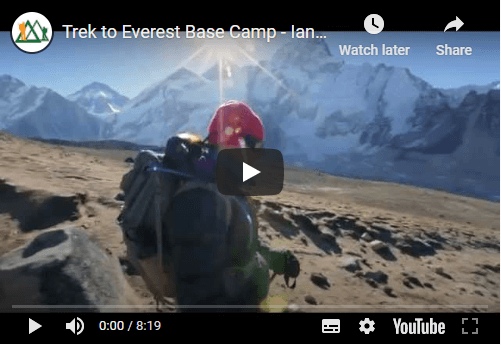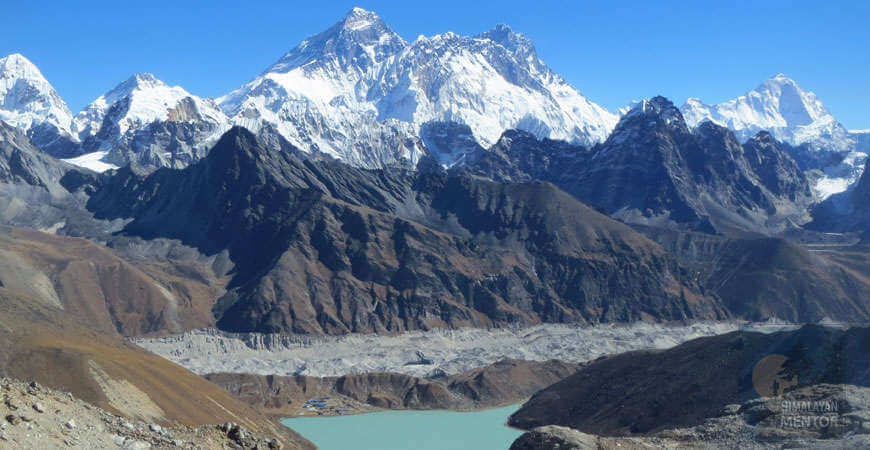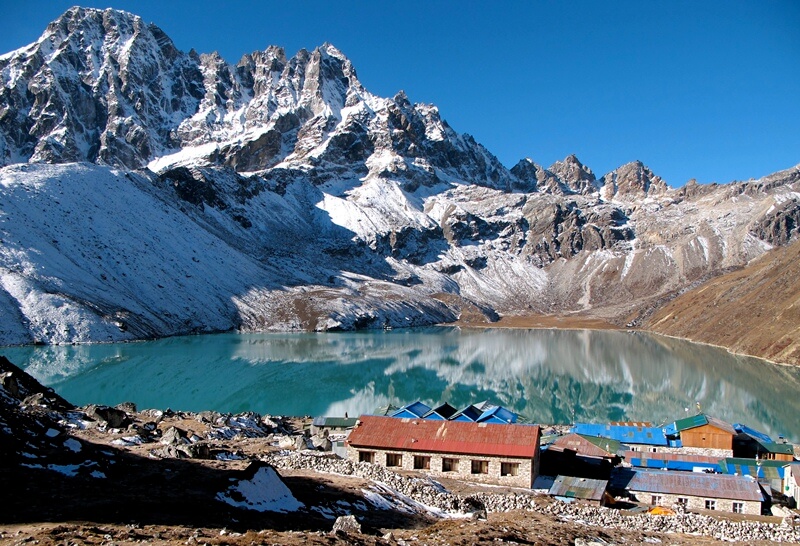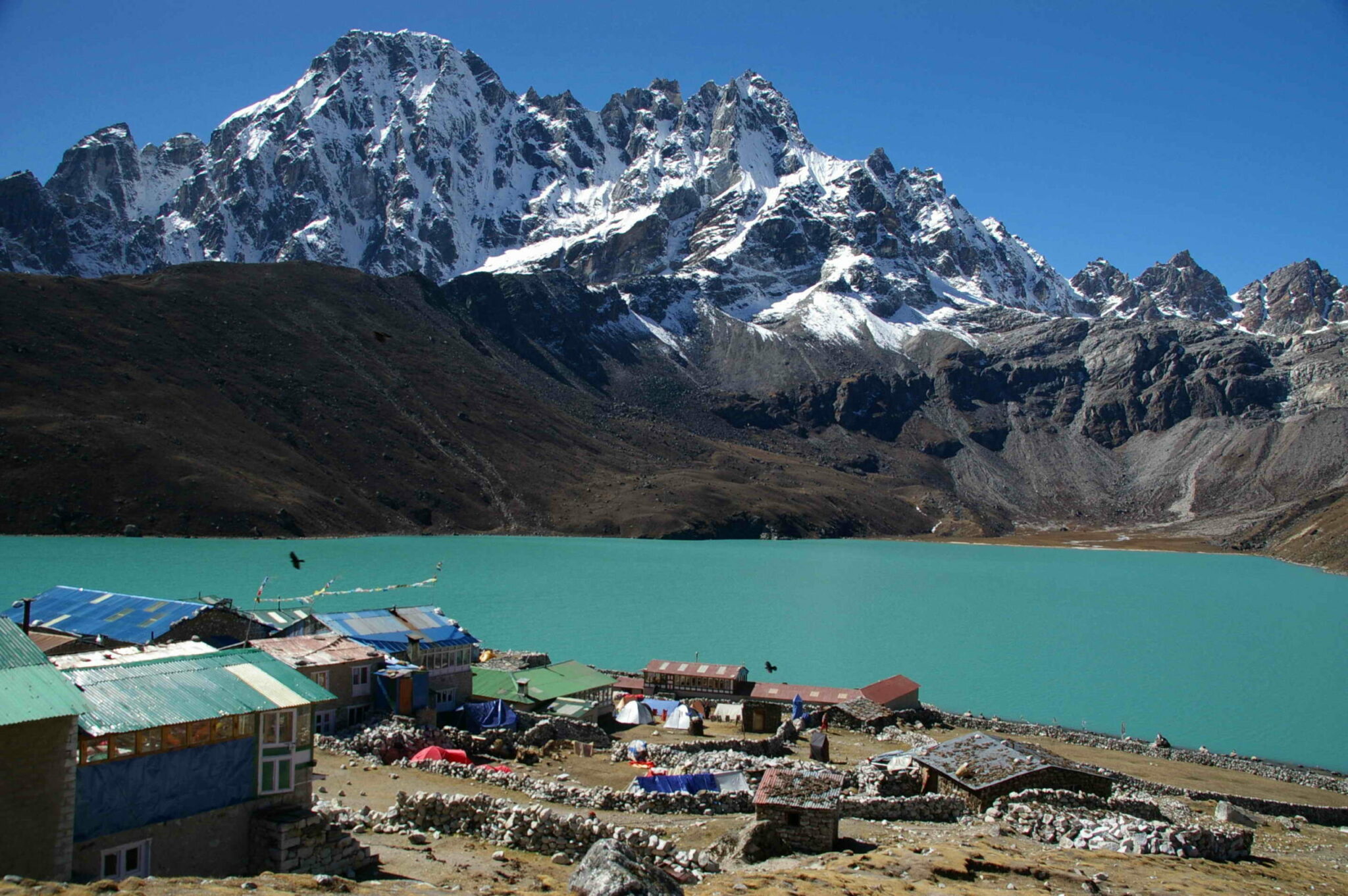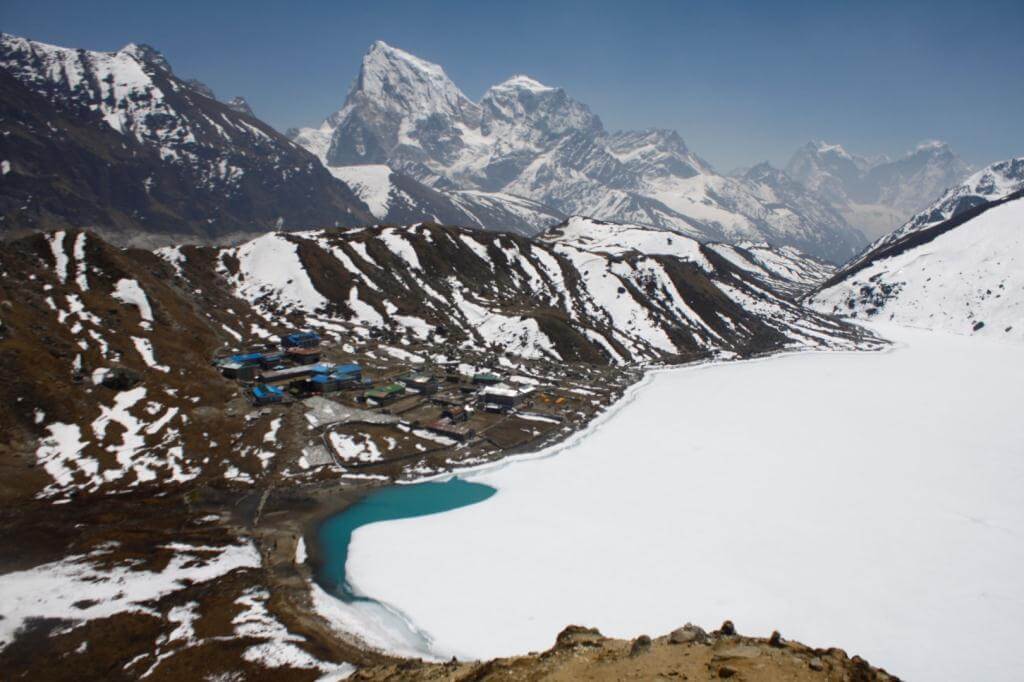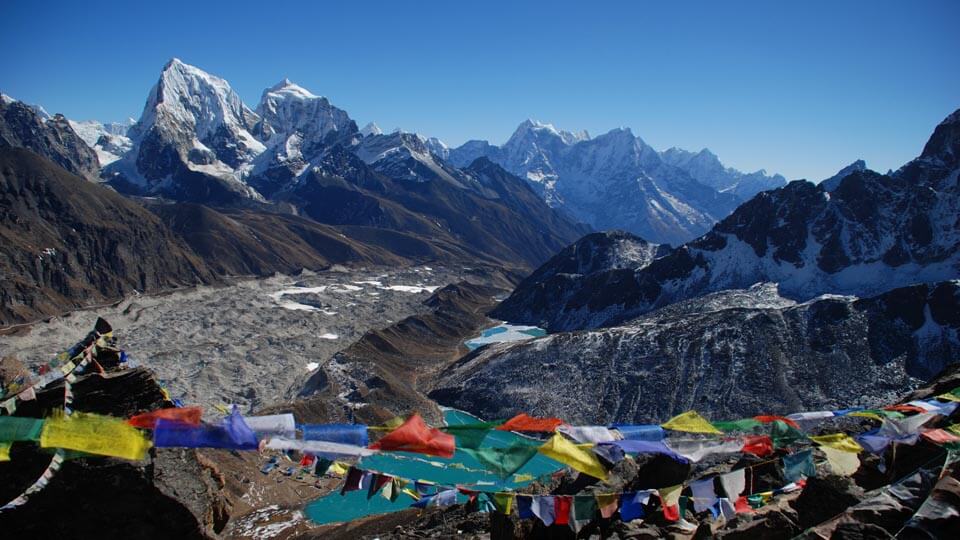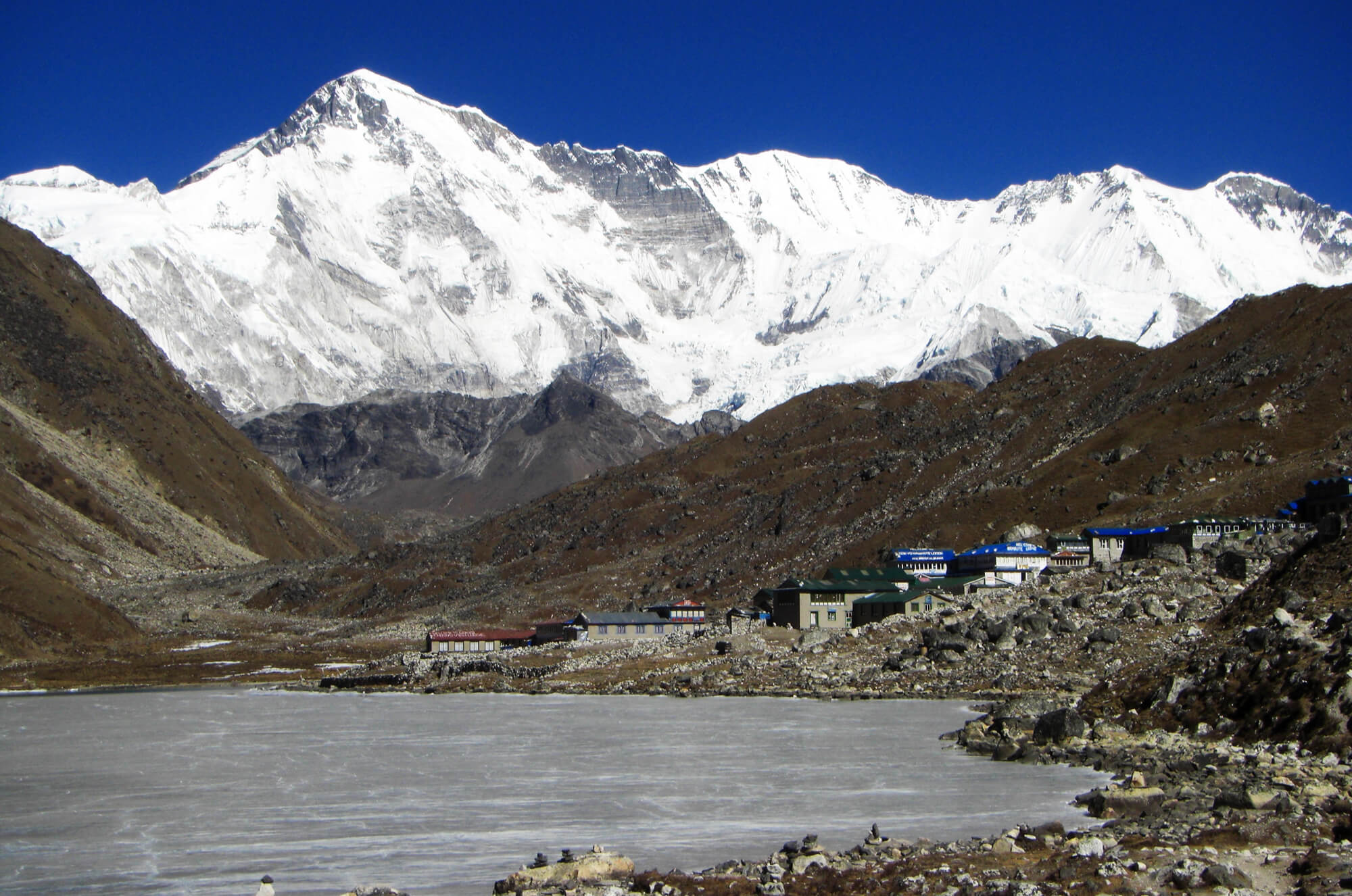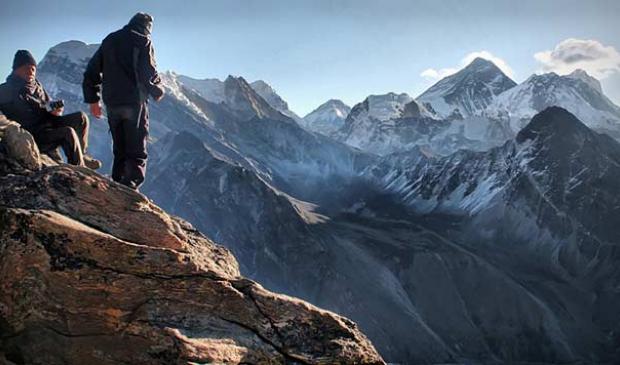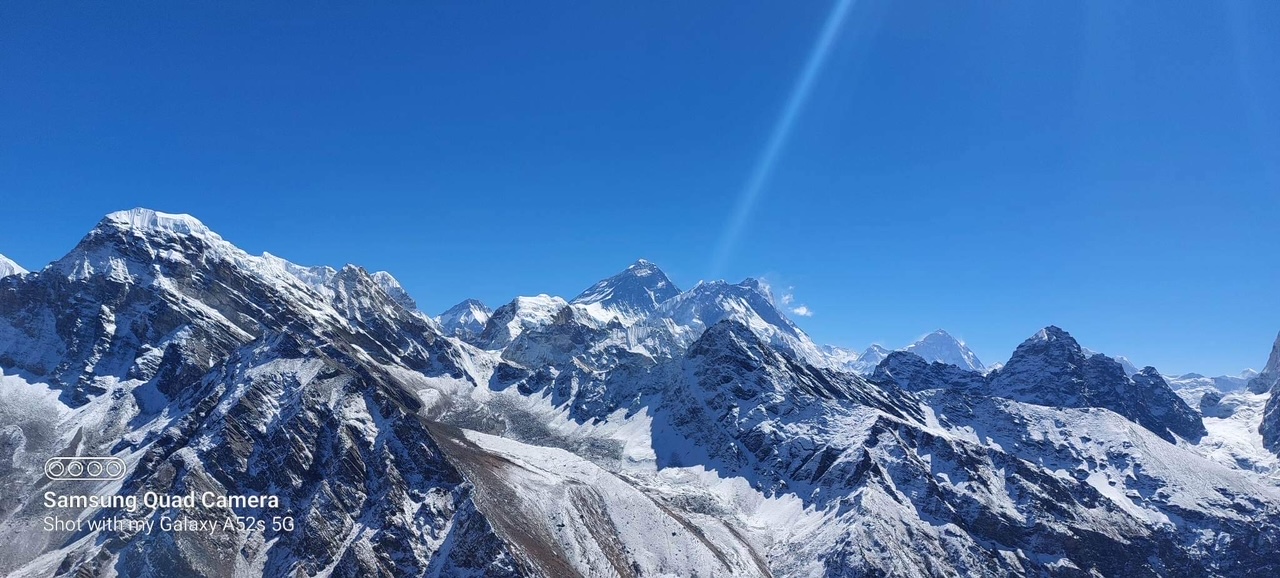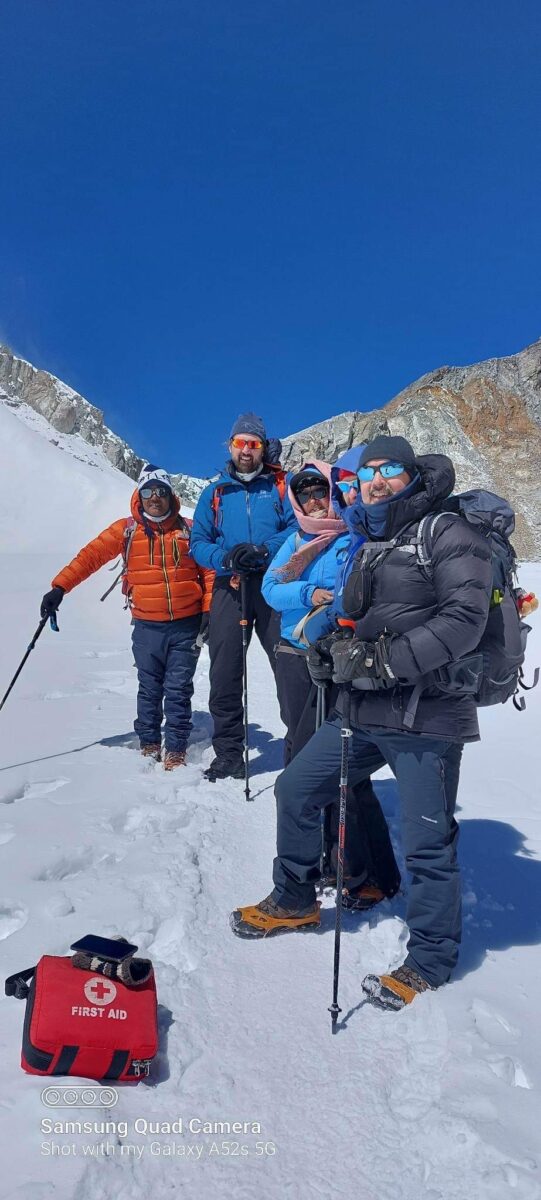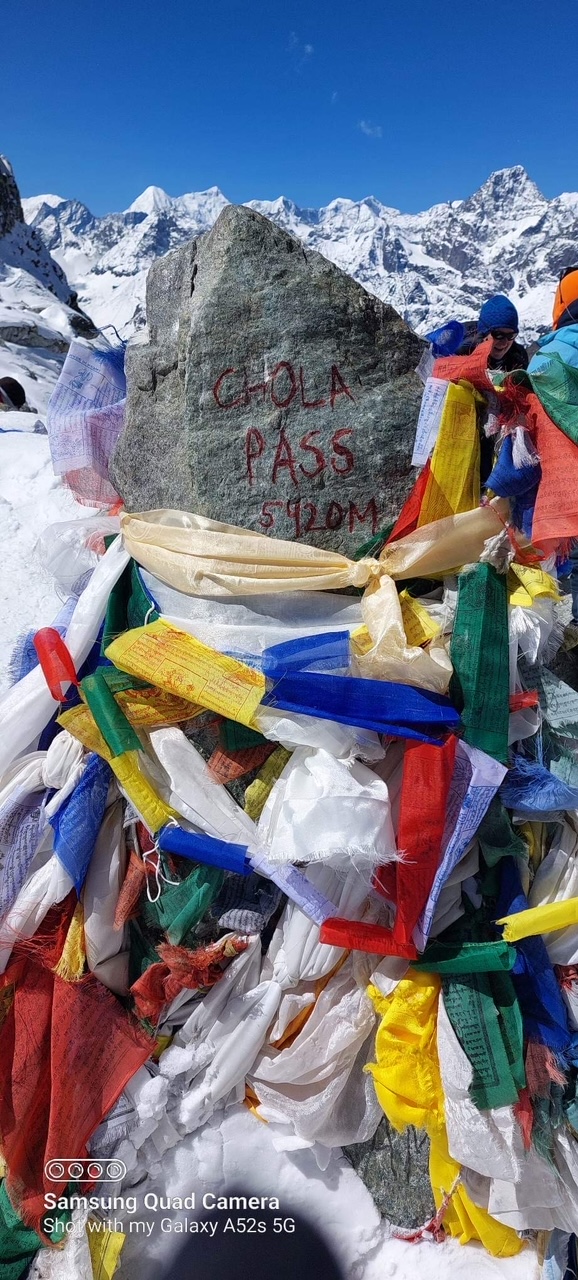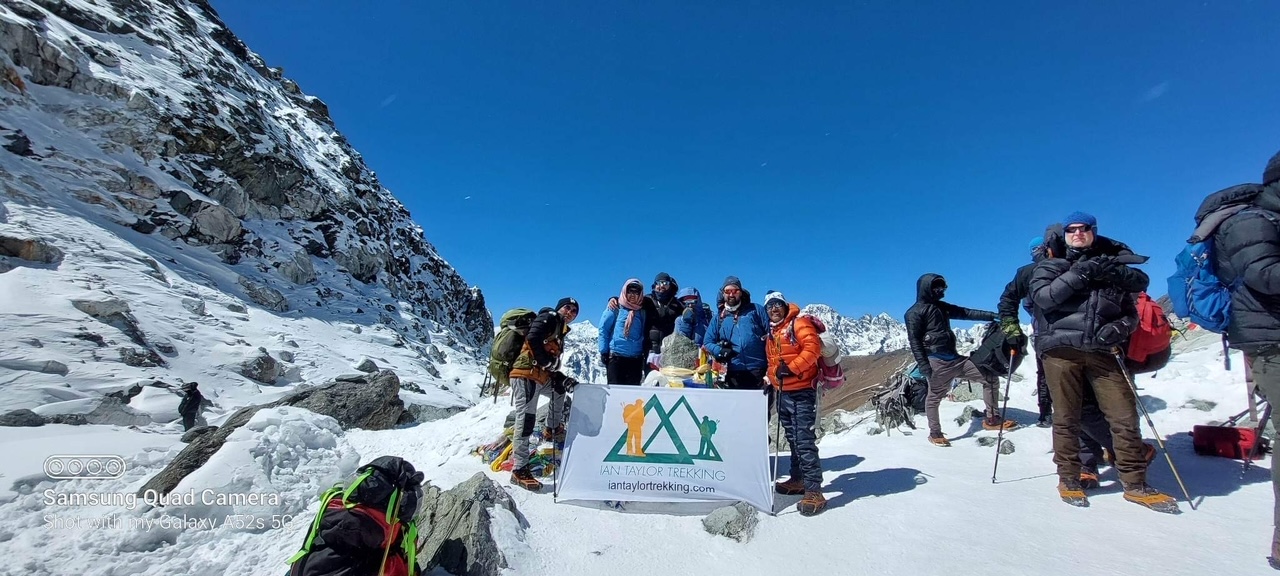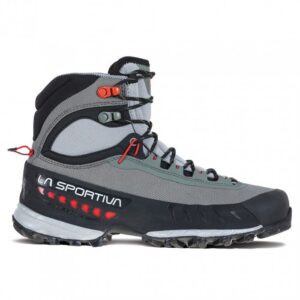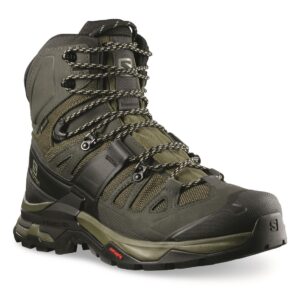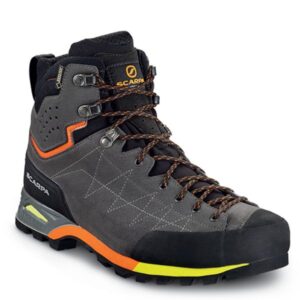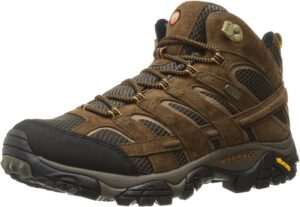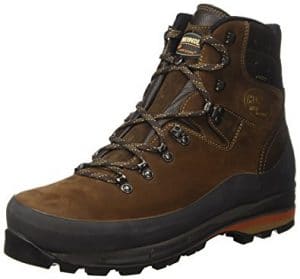Everest Base Camp Trek via Gokyo Lakes
Tips & Advice
1). Our Team
We have four guides for every group of ten trekkers on the trail! This is not the norm in the region and we do this because we want to make sure all of our teams have the best chance at safely reaching their goal. With more staff on the trail with your team, they will be able to more efficiently manage your safety on the trail and also give you a better experience along the way.
We only run quality treks with more staff, better lodges and better food. Read some REVIEWS from our trips.
2). Supporting the Community
We continue to support the local community and have helped to establish the Goli Village Trust in Nepal. This was put into place after the earthquake in 2015, when the Village where many of our staff have come from was devastated. We have built two schools in the Goli region and we have placed stoves in over 60 homes. We do need donations and help, therefore if you would like to donate, set up a trek to the village, give funds, clothes or school items, then get in touch. Please let us know and we can help you figure out how you can best help.
3). Expert Training Advice
We offer personal service with training advice for our clients, 5 days a week. A lot of people underestimate the trek to Everest, and rely on helicopters to get them out of the region when they become too tired to continue. We do not want to see this happen on our trips. Therefore, we want to make sure that you have the best information on how to complete the trek safely and successfully.
There are some long 8+ hour days, covering over 20km with over 700m/ 2,296 feet of up and down hill on steps or stairs while on the trail. We have professional training advice available to you 5 days a week and look forward to helping you.
4). 25 Years Experience
We have years of experience managing teams on the ground in Nepal. Our head guide has been at the forefront of tourism in Nepal for over 25 years. He is well connected on the ground with access to all the key organization and authorities. He is also passionate about the Sherpa culture, experience and preserving these traditions.
Anyone who has trekked with Dawa Chirri Sherpa will never forget it! Even if you just get to spend time in Kathmandu with him, you will love and cherish the experience. Dawa is married to Kay from Scotland, and they run our office together in Kathmandu. All of our clients joining trips to Everest Base Camp will experience the hospitality and quality service we have to offer.
5). Fully Trained Staff
All of our guides hold guiding qualifications and current Wilderness First Aid Certificates. Also, our guides will carry satellite and local phones with them. We bring oxygen on all our treks and climbs and the tea houses we use also house supplies of oxygen for emergencies. We lead climbs on Island peak, Mera Peak, Lobuche, Tent Peak, North Col, Cho Oyu and so many more. You need to have access to oxygen and team who have additional support staff members available to assist you while you are on the trek to Mount Everest.
6). Quality Gear
On our Sleeping in Base Camp trips, we use quality, North Face Tents on all our trekking and mountaineering itineraries in Nepal. We do have the option for a single tent for your night sleeping in Base Camp, however all accommodation are on a shared basis. Our Everest Treks are in the better lodges, however, if you are in a private group, you can chose to camp all the way if you prefer.
7). 4 Star Hotel in Kathmandu
We include two nights in a hotel in four star hotel in Kathmandu. One night before your trek and one night after. All of our trips are on a shared basis, but if you prefer a single room, this can be offered at an additional cost. We use the Encore by Wyndham hotel in Thamel, which is the main tourist district of the city.
8). We Run over 30 Treks to Everest Base Camp per Year
We have the experience and expertise to run over 30 treks a year to Base Camp. Ian Taylor Trekking are a well known and respected company in the region. Because of this, we get preferential treatment with everything from flights in/out of Kathmandu, to helicopters and room availability in the tea houses. Many companies without this experience bring you into the region and don’t even have tea houses booked beforehand. This could ultimately leave you stuck without a place to stay during busy times. We would never put our clients in this predicament… we always book beforehand to offer you a no-stress experience.
9). More Acclimatization
We have learned after years of experience that people need more time to acclimatize to the lower levels of oxygen, in order to have a safe and successful trip. Therefore, we now include three nights in Namche Bazaar at 3,500m/ 11,500 feet. This will help to give your body the time it needs to acclimatize correctly. Most companies are not doing this and we have seen over the years that it is a main factor in why more people on our trips are making it to Base Camp! We also include two nights in Dingbouche at 4,350m/ 14,271 feet, giving you the best chance of success!
10). Small Group Sizes
We only work with small group sizes. The maximum number of people per team will be 10 people. Some of our groups are even less people with only 6 or 8 team members. This will therefore give you are more personalized experience on the trail to Everest Base Camp. You can move as a team and experience more of this world class trail.
We only run quality treks to Everest with four guides for every group of ten trekkers. Having more staff on our trips gives you a safer and more enjoyable experience. We lead around 50 trips per year into the Everest region of Nepal. Over the years, we have become a world leader in offering quality run treks to Everest Base Camp.
Read our TOP 50 TIPS
We Have our own Full Time Staff on the Ground
All our office staff in Colorado have trekked to Everest Base Camp over 8 times. Likewise, they have slept at Everest Base Camp and climbed local peaks in Everest region like Island peak, Mera Peak and Lobuche peak. Therefore, if you sign up with us, you are getting the best available information about how to train and fully prepare for your trek to Everest Base Camp.
1). Pacing, Heart Rates and Attention to Breathing
If you are trekking to Everest Base Camp on an Ian Taylor Trekking trip, then you will have 3 nights in Namche Bazaar on the way up the trail, which will give you a safer and more enjoyable experience going to altitude. All we ask is you come with the correct physical preparation. On the trail, you need to maintain a slow pace that our guides set. Higher up the trail you will need to focus on deep breathing, in through your nose and out through your mouth.
2). Keep a Close Eye on your Surroundings
There are many objective dangers on different parts of the trek. People, porters, yaks, donkeys, rock fall and landslides are just a few of these dangers you may encounter. In order to avoid injury, need to make sure you are aware of your surroundings at all times. You also need to watch each step you take in risky areas. Your personal safety has to be your main concern at all times on the trail. Always stay on the mountain side of the trail and away from any drop offs.
3). Always Stay on the Mountain Side of the Trail
You need to be aware of your foot placement and stay away from the edge of the trail at all times. There are no railings, and with large numbers of trekkers, animals and porters carrying heavy loads, you never want to risk being pushed off the trail. Therefore, you always want to stand on the mountain side of the trail, NOT the drop off side. Stay well away from drop offs at all times. There are some serious and dangerous landslide areas on the trail. You need to move through dangerous areas very quickly, and our staff will help to manage you safely through them.
4). Walk in Single File in Risky Areas
Always walk single file as yaks and animals sometimes come out of nowhere and you need to be able to stay well out of their way. Using a trekking pole, placed out in front of you, can help steer yaks around you and your teammates. Just plant the pole out in front of you. Do not wave your trekking pole at any animal or hit them with your trekking poles.
5). Treat ALL Cold Water
When you get cold water in your bottle or bladder on the trail, you MUST treat the water with purification tablets before you drink it. Drinking dirty water can and will ruin your trip. As of January 2020, bottled water is no longer available in the Everest Region. You will NOT be able to purchase bottled water at any stage of the trail. Therefore, you will want to make sure you have adequate amounts of water purification tablets with you on the trip. You could also consider using a device like a SteriPen for the trip, however we have found that using the tablets is the easiest/most effective and cheapest option. If you are served water that has been boiled for tea, coffee, hot chocolate, it will not need to be treated.
6). Exercise is an Important Part of the Acclimatization Process, but you do not want to Fatigue your Muscles
Once you have come on the trip prepared and trained, this should not be a concern. On the trail, you will be walking for twelve or thirteen days straight, with 30% to 50% less oxygen. This will put your muscles, heart and body under a lot of pressure. You do not want to be moving fast up the trail each day, unnecessarily using energy. Our pace will be slow and steady, with plenty of breaks, especially on the longer hills, which can last for 2 hours. You need to regulate your heart rate as you slowly move higher each day. The correct way to breath at altitude is in through your nose and out through your mouth. This technique will be very important to your safety and success on the trip.
7). Drink 4/5 Liters of Water Each Day
When you are training at sea level, you should be drinking a liter of water per hour of exercise. Therefore, on the trail, you need to be drinking at least 4/5 liters each day. The International Society for mountain medicine defines high altitude as between 1,524m/ 5,000 feet and 3,500m/ 11,500 feet. Very high altitude as between 3,500m/ 11,500 feet and 5,486m/ 18,000 feet. And extreme altitude as any height above 5,486m/ 18,000 feet. The higher you go on the trail, the greater the effects are on your body and therefore, the more important it is to stay hydrated. We dehydrate much faster at high altitude, and when you fail to stay hydrated, you run the risk of altitude sickness and ultimately ruining your trek.
Lower oxygen levels make you breathe in and out faster and more deeply, causing you to lose more water through respiration. According to the wilderness medical society, you lose water through respiration at high altitude twice as quickly as you do at sea level. High altitude can also make you need to urinate more often and can blunt your thirst response, putting you at even greater risk of dehydration. So make sure you are drinking plenty of water on the trek.
8). Do not Ignore the Signs of Acute Mountain Sickness
Our treks to Everest base have 5 quality days of acclimatization on the trail. We spend three days in Namche Bazaar at 3,440m/ 11,300 feet and 2 days at Dingbouche 4,400m/ 14,435 feet. You need to be able to manage your ascent safely and never be afraid to let your guide know how you feel. Altitude sickness can kill, so respect the mountains and respect the decisions our guides make. Our guides are trained to deal with altitude sickness, therefore, they have the final word if you need to descend. If you do get altitude sickness, it will only get better by going to lower altitude.
9). You are Trekking as a Team
You need to look out for yourself and other people around you on your trek. Team work is essential for safe group travel. Look out for each other and you will enjoy the journey a lot more. If people cannot keep our minimum pace on the trail, then they should be turned around before they become a risk to themselves and the team. Please let the guides know if you or your team member is feeling unwell.
10). Have the Right Clothing, Gear and Equipment
There are too many people on the trail without the proper trekking equipment. Wearing cotton clothing, poor quality hiking boots or having small, insufficient day packs and the wrong clothing with minimal water will ruin your trip. Mount Everest and the Everest Base Camp Trek demands respect. The conditions can be harsh, even in the main trekking seasons of March, April, May, September, October and November.
11). Manage your Personal Hygiene
There are more and more shower facilities, western toilets, sinks and mirrors than ever before on the trail. There is also better and well prepared food in most of the lodges. On our treks, we use the better quality lodges, however in some villages the lodges are still of lower standards. You must assume that everything you are touching in the tea houses is dirty. Therefore, you will need to use hand sanitizer, cut your nails, clean your body and make sure you are limiting the risk of getting sick from dirty hands or touching unclean surfaces. Be aware you are in a remote wilderness location with limited resources and services, so please keep clean for a more enjoyable journey up the trail to Everest Base Camp.
Preparation & Training
We want to make sure that you get the right training and preparation for your trek to Everest. No matter where you are starting your training from, there are are some key processes you need to go through.
Putting a Training Plan in Place
There are a few factors you want to consider when planning your training routine. Firstly, you want to look at the daily distances on the trek. This will show you how far you will have to walk each day, back to back. Then, start to look at the elevation gains you will have on each day of the trek. This is going to show you how much up-hill and down-hill you will have each day. Once you look at both of these factors, and consider the lack of oxygen at high altitude, and you can start to put a training plan in place.
What Does The Everest Trek Involve
1). 12+ days of continuous hiking
2). Carrying a backpack with 6+kg/ 12+lbs for hours up and down hills
3). Hiking for a minimum of 5+ hours each day
4). Covering over 6,000m/ 20,000 feet worth of ascent and descent during the journey to Everest base camp and back.
5). On the way back down you will be hiking 20+km/ 12.4 miles per day on uneven terrain up and down hills.
6). All of this will be done at high altitude (Between 2,500m/ 8,202 feet and 5,500m/ 18,000 feet). Extreme altitude is above 5,550m/ 18,000 feet. At extreme altitude, people can not live or survive, and will ultimately die if you stay there for an extended period of time. You will be trekking where there is 30% to 50% less oxygen getting to your muscles. Therefore, your muscles are missing valuable oxygen to help you move, recover and sleep.
Train with Weight on your Back
Essentially, you need to be able to walk 10 miles a day in your training on a multi day basis. Also, your training always needs to be done with a weighted backpack as you built up to the trek. On the trail you will need to have a proper backpack with a good waist strap, and you will carry 6kg+/ 12lbs+ in that pack. In your training, you will want to be comfortable with carrying double that amount of weight. I have climbed Everest, Kilimanjaro 40+ times, Island peak 20+ times and lead 40+ treks to Everest base camp. We can help you understand this trip so you can come fully prepared. Read more.
Not everyone will have access to hills, but this is the best way to train your body and legs for down hill hiking. Depending on your chosen adventure you do need to assess the level of downhill. We have elevation gains available for all of our key trips. I encourage you to review the daily elevation drops and what type of terrain you will be walking on.
For example, on our Inca trail treks you will be drop 700m/ 2,296 feet to 1,000m/ 3,280 feet on different days all on steep rocky stairs. On Kilimanjaro you will drop 2,800m/ 9,186 feet in one day on scree and rock and this is very challenging on your legs and joints.
You have just walked for days on end you have reached your goal but not you have to retrace your steps, often in a quicker time frame. Hiking downhill will take its toll on your joints. Fore sure, the downhill hike will take more wear and tear on your joints and muscles than the uphill.
You do need to use effective training techniques to minimize the impact on your body. Descending using good technique means that you move faster and feel lighter. Remember, 80% of accidents happen on the way down.
Keeping Knees Healthy
We live in Eagle-vail Colorado with amazing access to altitude and a wide range of mountain terrain to train on. In Colorado we can train all year round on hilly terrain preparing for Kilimanjaro, Himalayan trekking and mountaineering trips. I know most of you are joining our trips from sea level and with minimal access to hill training. I encourage you to get out to Colorado doing some multi-day hiking in preparation for your chosen adventure.
If you do not have access to hills and mountains, you must figure out other ways to prepare your knee joints to handle downhill stress. From a knee perspective, downhill hiking means eccentric loading and typically thousands of repetitions of it. Eccentric loading (the lengthening phase of a contraction) is especially challenging to what is called the patellofemoral joint of the knee. This is where the knee cap, meets the femur. Inadequate strength, poor mechanics and lack of exposure to this type of loading can turn downhill forces into injury producing stress. Prior to your trekking trip you need to start implementing sport specific training into our general preparedness programming.
Hiking Uphill and Downhill
Hiking uphill is all concentric muscle action (muscle active while shortening) at the knee joint without any eccentric loading (loading while muscle is lengthening). Concentric only exercises tend to cause less mechanical stress, load and pain to joints and tendons than do exercises that have eccentric phases. What goes up must come down.
You must prepare our body and specifically your knees to handle downhill hiking. Depending on the trip, you really need 6 months of some sport specific training into our general preparedness programming.
The strength movements below are similar but slightly different in specific ways. We purposely only hit each one once per week because too much volume of these exercises could quickly lead to an over training injury, so be careful. I would recommend adding in additional hip flexor and quadriceps mobility work at the end of your training sessions as well to maintain good length tension relationships and to protect your spine.
The Point of These Exercises
Increase vertical loading volume of the knees with a sight posterior to anterior (back to front) force vector. Get exposed and accustomed to decelerating the vertical and forward forces using primarily a knee strategy. Transition from doing most lunges and squats with a 3 points of contact foot position to a more heel elevated position where we contact and press through the forefoot.
The 3 points of contact foot position is the most stable position for the foot and encourages a balance of hip and thigh musculature – great for general preparedness training. Transitioning to a heels elevated position where the forces are applied through the forefoot places most of the stress on the quadriceps and knees – optimal for downhill hiking training.
Exercises for Downhill Hiking
You should consider adding these movements into your weekly training 2 times per week. Add 3-5 sets of 10-15 repetitions (per leg)
1). Heels Elevated Goblet Squat
2). Forward Alternating Lunge with Farmers Carry Loading
3). Forward Alternating Drop from Box Lunges
4). Banded Posterior to Anterior (PA) Forward Lunges
Carrying Weight
One of the best ways of mitigating the risk of musculoskeletal issues is by carrying a light pack. Then build up the weight you carry over time. An overly heavy backpack is not recommended in the early stages of your training.
Extract its biggest toll on your body during steep and/or long downhill sections, so a hiker should always aim to travel as lightly as the dictates of their skillset and the environment into which they are venturing allow.
If you are carrying weight on longer hike you should slowly build up the weight you carry. You should also consider carry water uphill and dump as much water/ weight as possible for your downhill. Always assess the weight you are carrying for each hike and always build up slowly over time. You do not want to get injured.
Our Unique Itinerary
Day 1 - Arrive in Kathmandu – 1,400m/ 4,500 feet
Arrive in Kathmandu International Airport as early as possible on this day. We will provide your airport transfer to the hotel we include for the night. All accommodations on the trek are on a shared basis. If you want to arrive in early, that is not a problem, we are happy to book additional nights in the hotel for you. We will have a group briefing this evening to go over the schedule for the coming days and answer any additional questions you may have.
Day 2 - Fly to Lukla – Trek to Monjo – 2,850m/ 9,350 feet
Fly from Kathmandu to Lukla. We will make an early morning start for the Twin Otter flight to Lukla (2,840m/9,317ft), the gateway to the Khumbu Region. This is an exciting flight, which should give a glimpse of Everest in the distance. In Lukla, we will meet the rest of our trek staff and set off straight away for our first night in the mountain village of Monjo. Depending on what time the flight arrives in Lukla, we may have to stop in the town of Phakding (2,600m/ 8,530 feet) for the night. Hopefully, the team will make it all the way to Monjo. Both villages are situated on the banks of the Dudh Kosi, which drains the whole of the Khumbu Region, and is the main trade route for the entire region. This can be the busiest part of the trail. Today we will walk for 3 hours to Phakding and a total of 5 hours to Monjo. The total distance is 8.8 miles/ 13 km to Monjo from Lukla.
Day 3 - Namche Bazaar – 3,440m/ 11,286 feet
Today we will continue up the banks of the Dudh Kosi River, towards Namche Bazaar. Just past Monjo, we will officially enter the Sagarmatha National Park before following the trail through small villages. We will take a tea break along the way. After tea, the trail then crosses the confluence of the Dudh Kosi and the Bhote Kosi, on a high suspension bridge. The trail then climbs steeply uphill for about two hours to reach Namche Bazaar (3,440m/11,286 feet). This is a prosperous trading town and the capital of the Khumbu Region. Just across the valley to the east stand the peaks of Thamserku and Kangtega, both very impressive mountains. From Monjo, the trek today is approximately 4 hours and the total distance is 5 miles/ 8 km.
Day 4 - Namche Bazaar (Acclimatization Day) – 3,600m/ 11,800 feet reached
Today is an acclimatization day where we will walk to the Sherpa Museum at 3,600m/ 11,811. From here you will have stunning views of Mount Everest and the surrounding mountains. The key is to rest, relax and acclimatize at this height and will make all the difference as we go to high and extreme altitude. The afternoon will be at leisure in Namche Bazaar, resting, eating, and enjoying the sites! Remember that it is still important to continue to drink 4-5 liters of water every day on the trail. Today, the walk up to the Sherpa Museum is only approximately 30 minutes.
Day 5 - Namche Bazaar (Acclimatization Day) – 3,900m/ 12,800 feet reached
This is where our itinerary is different. Instead of heading up to 3,900m/ 12,800 feet and sleeping in Tengboche, we will stay in Namche another night giving you the best possible acclimatization program. During this critical acclimatization phase, we will spend time resting and trekking to higher altitudes to aid in the process. We will wake early for our acclimatization hike today, up to Shangbouche Hill at 3,900m/ 12,800 feet, for beautiful vistas of the whole Everest Region. The goal is to spend some time acclimatizing at this elevation before returning to Namche for lunch. The afternoon can be spent sampling the delights of the Namche Bakeries and local stores! The hike to Shangbouche Hill will take approximately four hours round trip.
Day 6 - Dole – 4,110m/ 13,152 feet
After three nights of acclimatization in Namche we move off the main Everest trail and move to Dole at 4,110 m/ 13,152 ft. We climb steeply out of Namche Bazzar up to Khumjung Village. From Khumjung, we can enjoy outstanding views of Thamserku, Kantenga, and Ama Dablam. The most strenuous ascent of the day is past the Mong La, a very enchanting place nested on the spur of Mt. Khumbila. An ancient historical Chorten stands at the center of the settlement of Mong La. We stop at the top of Mong La to admire the grandest views of surrounding snow-capped mountains and valleys while having lunch. While on the way it will not be unusual to spot wildlife, like pheasants, mountain goats, and the evasive musk deer. Traversing through forests, some waterfalls and bridges, we reach at Dole, a small place with only a few teahouses. We will be trekking for 6/7 hours today.
Day 7 - Machherma – 4,470m/ 14,663 feet
Today we move from Dole to Machherma at 4,470m/ 14,663 ft. We start the day with a steady climb up through a scenic ridge above Dole and the trail climbs via Lhabarma at 4220m/ 13,845ft to Luza at 4360m/ 14,304ft. The path is steep in most places as we pass through thorny bushes up to Lhabarma, which will offer us good views of Cho Oyu, the world’s 6th highest mountain. You will also see Kantega, and Thamserku the trail takes us through many summer settlements and a charming hamlet of Luza 4,360m/ 14,304ft. The pace will be slow and you need to keep well hydrated and do not over exert on the trail. Altitude sickness is real and you need to take your time. While ascending from Luza, the Dudh Koshi valley is deep like a canyon with its sheer sides. Walking along the hill side above thundering Dudh koshi passing through some small hamlets and through sandy spurs, we reach Machherma. Machherma is the last major settlement on the way up to Gokyo. The beautiful stream flowing down from the Kyajo Ri and Phari Lapche mountains runs through the middle of village before draining into the Dudh Koshi. It is the place where Khumbu people got first sighting of Yeti in 1974. At this juncture, we can make a visit to the Himalayan Rescue Hospital for a lecture regarding the altitude sickness, its precaution and primary treatment. Overnight at Machherma. We will be trekking for 4/5 hours today.
Day 8 - Gokyo – 4,800m/ 15,744 feet
Machherma to Gokyo 4,800m/15,744 ft. Early on today’s trail we will see fabulous views of both down the valley and of Mt. Kangtega, Thamserku, and northern part to the Cho-Oyu 8,201m/ 26,906ft. The valley widens as the trail reaches Pangka 4,480m/ 14,698ft after a gentle walk. Phangka is the place where an avalanche in 1995 killed 40 people. We descend to the river bank before beginning to climb up to the terminal moraine of the Ngozamba Glacier. It is a steep climb on the moraine. After crossing an iron bridge over a stream the trial levels out as it follows the valley past the first lake, known as Longpongo at 4,690m/ 15,387ft where we get chance to observe the Lama footprints on a stone. At the sight of the second lake, Taboche Tsho we become enchanted by the sparkling turquoise blue sheet of water sparkling in the sun. Little ahead of the second lake, we reach the third lake, the two linked by a surging stream. Gokyo village stands by the third lake and Cho-Oyu mountain as a backdrop sets an amazing spectacular sight at this junction. After lunch, we explore around the third Lakes, Dudh Pokhari. We spend night at a teahouse with comfortable bedrooms. 4/5 hours of trekking today.
Day 9 - Gokyo (Acclimatization Day) – 4,800m/ 15,744 feet
Gokyo Valley Acclimatization Day: There will be a hike up to the 5th and 6th Lakes. Today is full acclimatization day and we should not stay idle. If the weather is good, we grasp the opportunity to climb Gokyo Ri today instead of next day to enjoy the scene from one of the best viewpoints of the Everest Region. The view across Nepal and stunning peaks and magical lakes are worth the effort. About 3 km north of Gokyo situates the fourth lake with its high cliffs and peaks rising above it. The trail continues to fifth lake. If interested, we climb on a hill at the edge of the Lakes to get astounding views of Cho-Oyu, Gyachung Kang, Everest, Lhotse, Nuptse, and Makulu. We can see a lot more from here – the spot is called Scoundrel’s Viewpoint. Beyond the fifth Lakes, we will be at Cho Oyu Base Camp. Scenery here is breathtaking with Cho Oyu and Gyachung Kang seeming just a stone’s throw away. The northern part of the fifth lake provides fabulous views of Cho-Oyu Base Camp and biggest glacier of the world- the Ngazumpa glacier. Moved by the charm, we may even try to go sixth lake too but depends upon our own interest and time before heading back to Gokyo village. 4 -5 hours trekking today.
Day 10 - Gokyo Ri – 5,357m/ 17,570 feet – Thaknak – 4,750m/ 15,580 feet
Hike up Gokyo Ri 5,357m/ 17,570 ft. then head to Thaknak 4,750 m/15,580 ft. If we have not climbed Gokyo Ri the day before we trek there today. Gokyo Ri is one of the highlights of this trip. Early morning, we hike up to the Gokyo Ri (Gokyo Peak). Climbing to Gokyo Ri is strenuous as it is steep up and takes about 3 to 4 hours to reach the top. The trail vista of Gokyo village on the edge of third lake overlooked by Cholatse and the broad Nogzumpa Glacier are astonishing. We are surrounded by panoramic mountains like Kusum Kanguru, Thamserku, K43, Kangtega, Taboche, Cholatse, Makalu, Lhotse, Nuptse, Everest, Changtse, and Pumori. Watching the sun bounce off Everest that towers over all surrounding peaks. Your visit to Gokyo Ri will be unforgettable. After being inspired by the highest mountains in the world we trek down to Gokyo. After a well-earned breakfast we trek to Thaknak for overnight scaling by the second Lakes and the Ngozumba Glacier. 5/6 hours trekking today.
Day 11 - Cho-la Pass – 5,367m/ 17,604 feet – Dzongla – 4,830m/ 15,939 feet
Thaknak over the Cho-la Pass 5,367m/ 17,604 ft to Dzongla 4,830m/ 15,939 ft. Crossing the Cho La Pass is very challenging and not to be underestimated. Today is the toughest day of the trek and we need to start early at 4-6am compared to other days on the trip. The pass is not itself difficult, but it is steep and involves a glacier traverse on the eastern side. We need to be careful as the trail is steep and the rocks glazed by ice making this tricky for inexperienced trekkers. The trail from Phedi climbs through a ravine and a rocky trail as we climb up continuously. While trekking through the side of a frozen lake we reach at the top of the pass decorated with prayer flags. Ama Dablam commands the skyline over a range of mountains on the south even as Cholatse soar on the west and Lobuche East and Baruntse rises sharply to our right. We need to pass through some crevasses before we reach Dzongla, another beautiful place with a complete view of Cholatse, Ama Dablam, Lobuche peak and the Pheriche village far below. We will overnight at a very basic local lodge. 7/8 hours of trekking today.
Day 12 - Lobuche – 4,920m/ 16,142 feet
Dzongla to Lobuche 4,920m/ 16,142ft. Today’s hike will be a bit shorter. Thus, we would get more time to observe and relax. We move down from Dzongla and cross a bridge onto a grassy trail. Enjoying the view of Lobuche Peak we stretch up eventually through a ridge. Ama Dablam, Kangtega, Thamserku Taboche are seen looming prominently. Curving round through the wide gravelly river bed, we will arrive in Lobuche, a small hamlet of lodges where we will spend the night. 2/3 hours trekking today.
Day 13 - Everest Base Camp – 5,364m/ 17,600 feet – Gorak Shep - 5,180m/ 17,126 feet
Today is the day we trek to Everest Base Camp! We will be up early to start our trek to Gorak Shep, which takes approximately 3 hours to reach 5,180m/ 17,126 feet. Today is a very challenging day on the trail, as we cross glacial moraine on mixed rocky terrain with a lot of up and down hill to cover. Gorak Shep was the site of the 1953 Everest Expedition's Base Camp and where we will stop for an early lunch before continuing to Everest Base Camp. From Gorak Shep, we will traverse more glacial moraine, with landslide potential, for another two hours before reaching Everest Base Camp! Everest Base Camp sits on the Khumbu Glacier and weather depending, we will have time to explore this once and a lifetime chance to be at the base of the World’s Highest Mountain! After approximately one hour here, we will retrace our steps back to Gorak Shep, where we spend the night. Total trekking time today is approximately 7 hours and covers 6.2 miles/ 10 km in distance.
Day 14 - Kala Patthar (5,645m/ 18,520 feet) to Pheriche – 4,200m/ 13,780 feet
Today is another big day, but one to remember forever! Normally, the plan is to start hiking at around 4 am, because you want to arrive at the top of Kala Patthar just before sunrise. The trail from Gorak Shep leads steeply uphill all the way to the top of Kala Patthar at 5,645m/ 18,520 feet. This takes approximately 2 hours to reach the top and the views off Kala Patthar are spectacular and you will be rewarded with the famous view of Mount Everest! After enjoying the mountain views at the top, we will return to Gorak Shep, which takes about one hour. There, we will pack bags and have breakfast before continuing back down the trail. We will then retrace our steps through the Lobuche, the Everest Memorial and usually stop in Thukla for lunch. From here, we will take the lower trail to the village of Pheriche at 4,200m/ 13,780 feet, for the night. The total distance today is 11.2 miles/ 18 km and will take approximately 7 – 8 hours.
Day 15 - Pheriche to Namche – 3,440m/ 11,286 feet
The trek today will be another long and challenging day. From Pheriche we head back through Pangbouche, then uphill into Tengbouche where we stop for tea. From Tengbouche, the trail continues downhill for one hour to our lunch spot, beside the river. After lunch, there is a one hour and thirty minute ascent, back up to the Ama Dablam View Guesthouse, where we will have a final short break. There is another approximately hour and thirty minutes before we reach Namche Bazaar. This is a long day as we will only arrive in Namche in the late afternoon. It is now time to take a shower, relax and get some rest! The hike today is approximately 8 hours and will cover 13.7 miles/ 22 km.
Day 16 - Lukla – 2,850m/ 9,350 feet
Today is the final day of trekking!! It will be another long day as we must get all the way back to Lukla for the night. The day starts with a one hour descent from Namche, back to the high suspension bridge. Following the river from here, you will have to trek up and down stairs and trails, retracing our steps back to Phakding, where we will stop for lunch. After lunch, it will be a gradual two-and-a-half-hour ascent back into Lukla at 2,850m/ 9,350 feet. The hike today will take approximately 8 hours and we will not reach Lukla until late afternoon. The distance covered today is 13 miles/ 21 km and you will enjoy your final night spent in the Everest Region tonight.
Day 17 - Fly to Kathmandu – 1,400m/ 4,500 feet
We will wake early today and have breakfast before returning to the Lukla Airport for the flight back to Kathmandu. If the weather is cooperating, then you would be back in the hotel in Kathmandu by early morning! You can spend the day at Leisure in Kathmandu, enjoying the sites, including Pashupatinath, Swayambhunath and the districts of Bhaktapur and Patan. Durbar Square is also on the essential list, as is the shopping area of Thamel or get a treatment at one of the many spas in Kathmandu. We include a celebration team dinner in a nearby restaurant and the night in the hotel is also included on a shared basis.
Day 18 - Kathmandu
Today is the final day of our itinerary. We recommend that you do not book your return flight until no earlier than the evening on this day. That will be critical if there are any delays getting out of the mountains on the day before. We include your return transfer back to the international airport for your onward journey. If you want to spend any extra time in Kathmandu, we are happy to book additional nights for you in the hotel.
Equipment
Remember that the gear you bring will also depend on what time of year you are doing the trek. You will need warmer layers if you are trekking in February, March, November and December.
What Ian will Pack
This video is designed to show what Ian would bring on his trek to Everest Base Camp. Ian has made the journey to Everest Base Camp over 40 times, stood on the top of Everest and lead each of those treks in different conditions. This is the gear and clothing Ian has used on his numerous treks and expeditions into the Everest region. From recent treks, Ian recommends adding a down vest as an additional layer on the trek to Everest.
No One Size Fits All
1). La Sportiva TXS GTX
This is a new boot from La Sportiva, that has replaced our beloved Trango Trek GTX. We prefer a more rigid sole under foot and these boots do a great job. They are warm, lightweight and waterproof. Some of our Sherpa and Kilimanjaro guides wear these boots as well. Ian used these boots on four Kilimanjaro climbs this year along with three Everest Base Camp trips, and they are still in great condition for the same again next year. We would also use them training and on other treks in Nepal and South America.
2). Salomon Quest 4 GTX
Another great option is the Salomon Quest 4 GTX Trekking boots. More and more people are using these trekking boots on a wide range of our trekking adventures in Nepal and around the world. They are comfortable, sturdy, waterproof and a very resilient trekking boot. We would recommend these boots for Everest Base Camp, Kilimanjaro, Mount Elbrus, and a range of other treks.
3). Scarpa Zodiac Plus GTX
Scarpa has come out with a new light weight option in the Zodiac. These boots are Gore-Tex, so a waterproof boot to keep you dry if you experience moisture on the trail. They also have good ankle support and lacing system. These boots, similar to the La Sportiva TXS, have a more rigid sole, which is ideal for the terrain on the trail to Everest Base Camp. Scarpa are always re-inventing trekking boots and if they fit your foot correctly, then they may be the right boot for you. They work great and last a long time. We would also recommend these boots for a Kilimanjaro climb, Elbrus or the Inca Trail.
4). Merrell Moab Mid 2 Waterproof
The Merrell Moab Mid 2 Waterproof Trekking Boot has been around for years and there is a good reason for that, they are a great boot! These boots boast a waterproof membrane, good ankle support, comfortable and sturdy fit. The Merrell boot may be the option for you if you have a slightly wider foot or need more room in your toe box. This boot is a reliable and durable option that will be ideal for your Everest Base Camp Trek! We would also recommend this boot for Kilimanjaro, Annapurna Base Camp or the Inca Trail.
5). Meindl Vakuum
You could also consider using the Meindl Vakuum trekking boots. These are a good option for Everest Base Camp treks and a wide range of trekking peaks and multi-day trekking adventures. These are a very popular boot and we see a lot of clients arriving to Nepal in this option. They are an excellent choice for mixed rocky terrain and long distance hiking. These boots will be with you for many miles as they are an extremely durable boot. Also, this could be a good option for you if you feel the cold in your feet as they will be a warmer option.
FAQ
Q). How much does a visa cost to enter Nepal?
A). Visa entry for Nepal costs USD $50 for a 30 day visa and USD $100 for 90- day visa.
Q). How much is a meal in Kathmandu?
A). An average meal in Kathmandu is approximately USD $10 – $15 per meal.
Q). How much should you tip your guides after a trek to Everest?
A). The tip given at the end of a trek should be roughly USD $150 – $200.
Q). Can I leave spare luggage in the Kathmandu hotel while I am on the trek?
A). Yes, the hotel we use in Kathmandu has a luggage storage room for any travel clothes or spare items you want to bring with you to Nepal, but not on trek.
Q). Is there WiFi in the Everest region?
A). Yes, if it working. We recommend purchasing an Everest link card in Namche is is $25 approx. for 10GB. Once you see an Everest link connection you can log in with your card. Record your password, just in case you lose your card.
Q). Where do I get water from on a trek to Everest?
A). You should use water purification tablets in the 4/5 liters of water you will be drinking each day. Avoiding water borne illness on the trek is imperative! You can buy these in Kathmandu or on the trail to Mount Everest. Bottled water (plastic) has been outlawed in the Everest region as of 2019. Therefore, you will not be able to purchase bottled water anywhere along the trail any longer. You will want to make sure that you have adequate amounts of water purification tablets with you for the entire trek. 30 minute treatment is ideal. Check when you purchase.
Q). Is the Everest Region expensive?
A). The higher up the trail you go in the Everest Region, the higher the price tags are for items! Anything you want to purchase in the region has to be carried in on the back of a porter or animal, which is why things are more expensive the further they have to travel. Boiled water in Nalgene, for example, is between USD $2 – $4 and this will vary the higher up you go. Coffee can be $3 – $5.
Q). When is the best time to trek to Mount Everest Base Camp?
A). What time of year you should go to Everest Base Camp will depend on the experience you are looking for. Some of our favorite times to be in the region are late October into November, where the crowds start to dissipate and the temperatures are a bit colder, bringing the crisper and clearer views. Another popular time to visit is March and April. April is one of the busier months to be in the region – but there is a reason for that! Generally, the weather is stable and the views are clear, with less heat haze that can impede the views.
Q). When is trekking season in the Himalayas?
A). There are two distinct trekking seasons in the Himalayas; pre-monsoon (February, March, April and May) and post monsoon (late September, October, November and December). It is also possible to make the journey in January and early September. Our personal favorites are March, April, late October and November.
Q). When is the Everest Base Camp quiet?
A). The quietest time to visit the Mount Everest Base Camp are January, February March, September, November and December.
Q). When is the warmest time to visit Everest Base Camp?
A). May and September are usually the warmest time to visit Everest Base Camp. However, while we normally see warmer temperatures in May, we have also seen years where it has snowed on the trail and been quite cold along the way! You never know what the weather will be like in the region, but generally May is a warm time to be there.
Q). When is the main climbing season in Mount Everest?
A). The main climbing season on Mount Everest is April and May each year. This means that if you want to see Everest Base Camp with all the tents and action, then one of the trips during the months of March, April or May would be best for you.
Q). What vaccines do I need to get to visit Mount Everest Base Camp?
A). The recommended vaccines to receive before trekking to Mount Everest Base Camp include tetanus, Hepatitus A, Hepatitus B, Typhoid, Poliomyelitis, Rabies, Meningoccal Meningitis, Japanese Encephalitis, and the Covid-19 Vaccine.
Q). Which vaccines are required to visit Nepal?
A). Unless you are entering Kathmandu from tropical Africa, then there are no legally required vaccinations to enter or exit from Nepal. Even though there are no required vaccines, there are, however, some that are recommended. We suggest that you keep up to date with the current vaccine list through the CDC or your local Travel Medical Center. The recommended vaccines will also depend on when or where else you will be traveling when you visit Nepal as there are different recommendations for different regions. The general recommended vaccines to receive, however, include tetanus, Hepatitus A, Hepatitus B, Typhoid, Poliomyelitis, Rabies, Meningoccal Meningitis, Japanese Encephalitis, COVID-19, and Yellow Fever (only if traveling from a country with Yellow Fever).
Q). How do I choose the right lodges for a trek to Everest?
A). Ian Taylor Trekking offer some of the best accommodation on offer for every trek. Our service is second to none. We use the same lodges on every trek. The lodge owners know us and we know them. This helps us offer you consistency for your trek. We have been building relationships in the region for years to make sure you have the most comfortable experience on your journey to Everest Base Camp.
Q). Is it difficult to trek to Everest Base Camp?
A). One of the most common questions we get is people asking if it is difficult to trek to Everest Base Camp? This is a relative question. For people who are used to hiking long distances, with a weighted back pack over years, they might find the trek relatively easy. However, for people who have no access to hills, or that are not used to hiking or training on a regular basis, they will need to train hard for this trip and will likely find it very difficult. Likewise, the older you are, the more training is needed. Learn More.
Ian has journeyed to Everest Base Camp and Kala Patthar over 40+ times to date and climbed to the top of Mount Everest. Ian and other of our team members have made the journey many times, however, each time is different! Doing the correct training and putting in the right preparations for the trek will be essential to your enjoyment, safety and success.
Why Trek to Mount Everest Base Camp via Gokyo Lakes with Ian Taylor Trekking
We only run quality treks to Mount Everest Base Camp via Gokyo Lakes, with the best staff, service, acclimatization, and itineraries. All of our teams have 4 guides for every group of 10 trekkers.
We have developed a wonderful team of full time staff on the ground in Nepal, who work directly with us year round. Our team has the experience and knowledge to help make sure you have the right advice and information for your trek to Everest. Pick up the phone or email us today to discuss your adventure to Nepal!
Ready to go?
If you need any further information, please feel free to get in touch with us directly! You can email us at info@iantaylortrekking.com and we will send through all the relevant information for your Everest Base Camp via Gokyo Lakes Trek! Once you sign up to one of our trips, we will send out a complete Dossier on your trip. This will help answer questions on preparation, gear, vaccinations and all the important information on your journey.
We are a world leader in running Everest Base Camp treks and would love to be a part of your adventure. Get in touch today and make the dream of standing at the base of the worlds tallest mountain a reality!


